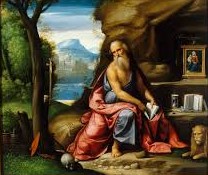
How Could God Possibly Love Us?
I don’t recall how, but I recently came across the above painting of St. Jerome by a 15th century Italian artist named Benvenuto Tisi da Garafalo. Being nearly illiterate in art, I had never heard of him or his painting of St. Jerome.
But I’ve always been interested in St. Jerome, who lived almost 200 years before Garafalo painted his picture. I’ll get to why St. Jerome interests me, but first, a bit about the painting.
Garafalo evidently was a tireless painter of religious subjects, especially of Mary, the mother of Jesus. This painting of St. Jerome strikes me as a bit bizarre for modern observers, picturing Jerome with his shirt undone and several strange objects around him while he holds a book in his hand. His face is evidently meant to show him thinking about what he’s reading – thus, the painting’s title, “Meditation of St. Jerome?”
Among the First Christian Scholars
That title makes sense because Jerome is counted as among the first Christian scholars. Born between 342 and 347, he had a wild early life in Rome before converting to Christianity and retiring to the Syrian Desert to become an ascetic. But he didn’t spend all his time meditating. He learned Hebrew from a converted Jew and began his translation of the Bible from Hebrew and Greek to Latin.
He completed his translation in Jerusalem, according to Wikipedia, and returned to Rome when he became a collaborator of the Pope and a prolific writer on theological matters. There he also engaged in “unsparing criticism of the secular clergy” for their laxity and corruption.
But what interests me about Jerome was his inconceivable Bible translation with so little resources while in the desert and even in Jerusalem. He obviously had no Internet or even a library. He was undoubtedly fluent in Latin and Italian but able to learn Greek and Hebrew sufficiently to understand ancient writings and put them into a language that his contemporaries could understand.
Long Line of Christian Thinkers
He also interests me because he was among the first of a long line of Christian thinkers who was wholeheartedly dedicated to the search for God. He undoubtedly asked the questions we do: who or what is God and what is the evidence for faith? And how do we know him and love him, and how can God love us in return?
When I try communicating with God I sometimes wonder how God, creator of the universe, could love us fickle, petty, self-centered, and insignificant humans.
But a recent attendance at a Catholic mass gave me insight. Though I’ve probably heard the words hundreds of times, I recently heard a phrase the priest uses in what is known as the canon of the Mass that particularly struck me. Referring to Jesus, the priest asks the Father “to see and love in us what you see and love in him.”
Of course, it’s still not easy to grasp or hold onto. We see too much that we don’t like in ourselves and others to rest easy in God’s love. For me, it’s an ongoing task to wholeheartedly accept God’s love and return it in kind.
Pope Francis Acknowledges the Problem
In a 2018 homily, Pope Francis acknowledges the problem.
“It is a love that cannot be understood,” he said, “a love that surpasses all knowledge. It surpasses everything. The love of God is so great; a poet described it as a ‘bottomless sea without shores…’ This is the love that we must try to understand, the love that we receive.”
Francis quotes Hosea, the prophet who, putting words in God’s mouth, wrote in reference to his people: “I led them with cords of human kindness, with ties of love. To them I was like one who lifts a little child to the cheek, and I bent down to feed them.”
So, how do we love God in return? Mostly, through our love of others, says the Pope, who said that love is about “carrying on God’s own work in your own small way: that is feeding the hungry, quenching the thirsty, visiting the sick and the prisoner.”




